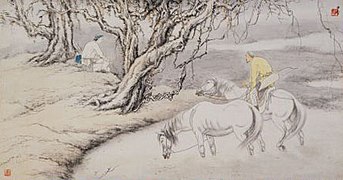Hashimoto Kansetsu
Hashimoto Kansetsu ( Japanese 橋本 関 雪 ; born November 10, 1883 in Kobe ( Hyōgo Prefecture ); died February 26, 1945 ) was a Japanese painter of the Nihonga direction of the Taishō and early Shōwa periods .
life and work
Hashimoto Kansetsu was the eldest son of Hashimoto Kaiseki (橋本 海関), an expert on Chinese literature from Akashi- resident Echizen-Matsudaira . In 1895 Kansetsu received his first lessons from Kataoka Kōkō (片 岡 公 曠), a painter of the Shijō school . In 1898 he went to Tokyo, but returned to Kobe the following year. In 1903 he made a second attempt, went to Kyoto and became a student of Takeuchi Seihō . In 1908 he stayed in Tokyo again, where his picture "銀 嶺 城外 の 宿 雪" (Ginreijō-gai no jukusetsu) was accepted at the 2nd state art exhibition "Mombushō bijutsu tenrankai" (文部省 美術展 覧 会) in the same year. He continued to exhibit there and occasionally received awards. In 1916 his picture " Han-Shan and Shide " was awarded at the 10th exhibition and in 1917 at the 11th exhibition the picture " 倪雲林 " was awarded as "outstanding contributions".
In between, Hashimoto had visited China in 1913 and then settled in Kyoto on return. In 1919 he became a juror for the now "Teikoku bijutsu tenrankai" (帝国 美術展 覧 会) called state exhibition series. The Shinsō-kai (新 篁 会, Shinkō-kai) association founded by his students at that time dissolved again in 1925. Two years earlier he had separated from the association of Takeuchi Seihō's students, the Chikujō-kai (竹杖 会).
Hashimoto traveled to Europe in 1921 and 1927 and to China about 60 times. In 1931 he was shown at the Japanese Painting Exhibition in Berlin. - He developed a new style within the Nanga , which he modified with his knowledge of Chinese, but also to Western painting. In 1934 he became an artistic member of the court office (帝室 技 芸 員, Teishitsu gigei-in), in 1935 a member of the Academy of Arts .
Hashimoto's best pictures include
- "Mokuran-shi" (木蘭詩; 1918), a series of images on the story of the young lady Hua Mulan ,
- "Iba Shin'en" (意 馬 心 猿; 1928): The title is a so-called "four-character memorandum" adopted from China, which can be translated as "attention of a horse, heart of a monkey",
- "Gen'en" (玄 猿; 1933): monkeys in a tree.
The work "Gumba nidai" (軍馬 二 題), for which he received the Asahi Prize in 1939, comes from the time of the Pacific War , from which the 1943 triptych "Jūnigatsu yōka Jiang Kōhokō jō" (十二月 八日 の 黄 浦江 上; "December 8 over the Huangpu "), which depicts a Japanese attack on Shanghai and - with reference to December 8, 1941 - refers to the entry of the United States into the war with Japan.
Hashimoto left behind a number of writings, among which his introduction to Nanga (南 画 へ の 道 程, Nanga eno dōtei; 1924) and the essay volume "Kansetsu zuihitsu" (関 雪 随筆) from 1925 should be emphasized.
Pictures (story of the young lady Hua Mulan | monkeys)
Individual evidence
- ↑ Uehara, Yoshio: Iba Shin'en . In: Joji jukugo jiten. Seito-sha, 1989. ISBN 4-7916-0205-6 .
literature
- National Museum of Modern Art, Kyoto (ed.): Hashimoto Kansetsu . In: Kyōto no Nihonga 1910–1930. National Museum of Modern Art, Kyoto, 1986. ISBN 4-87642-117-X .
- Tazawa, Yutaka: Hashimoto Kansetsu . In: Biographical Dictionary of Japanese Art. Kodansha International, 1981. ISBN 0-87011-488-3 .
- Laurance P. Roberts: Hashimoto Kansetsu . In: A Dictionary of Japanese Artists. Weatherhill, 1976. ISBN 0-8348-0113-2 .
Web links
| personal data | |
|---|---|
| SURNAME | Hashimoto, Kansetsu |
| ALTERNATIVE NAMES | 橋本 関 雪 (Japanese); Hashimoto Kan'ichi (real name); 橋本 関 一 (real name, Japanese) |
| BRIEF DESCRIPTION | Japanese painter |
| DATE OF BIRTH | November 10, 1883 |
| PLACE OF BIRTH | Kobe ( Hyogo Prefecture ) |
| DATE OF DEATH | February 26, 1945 |






